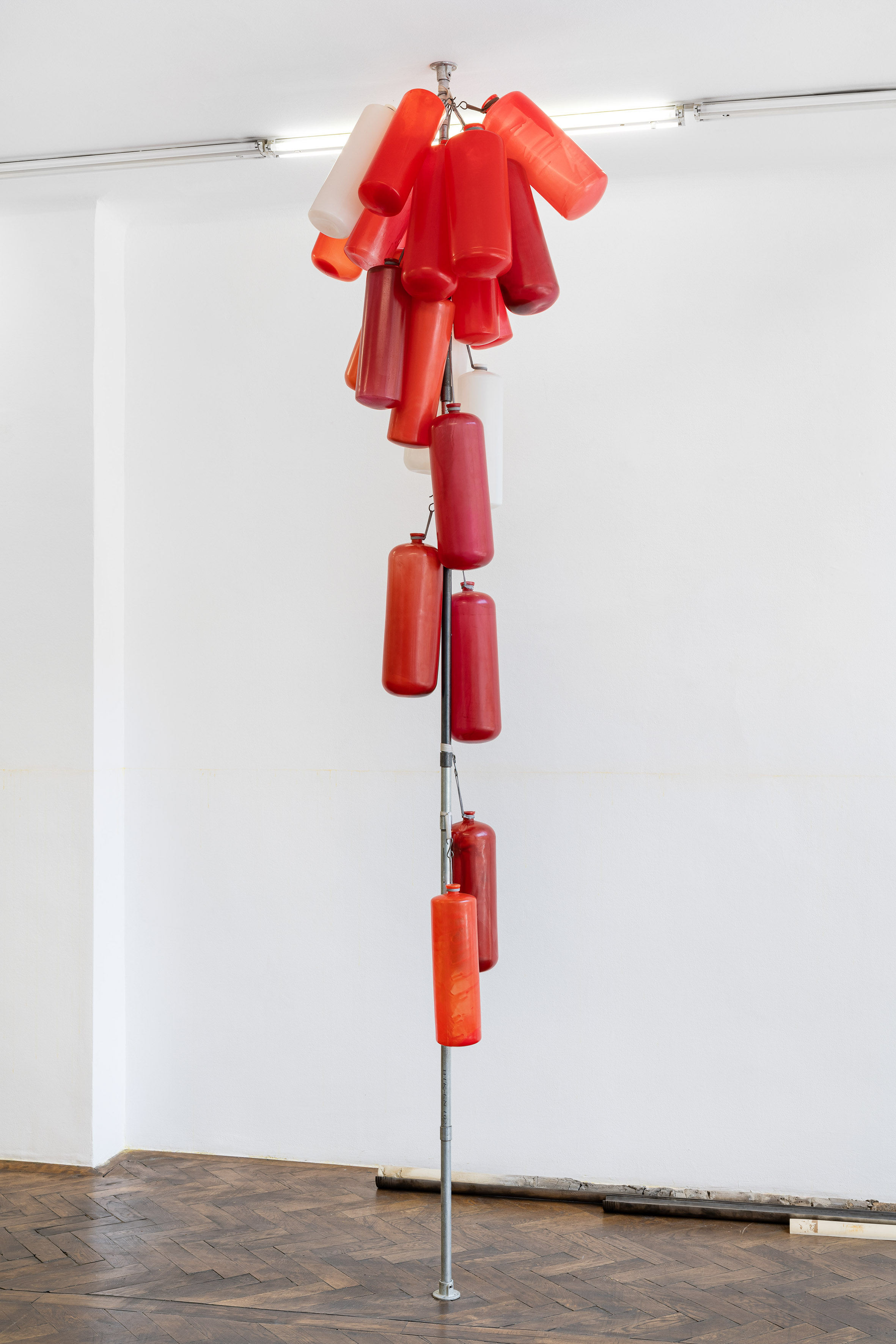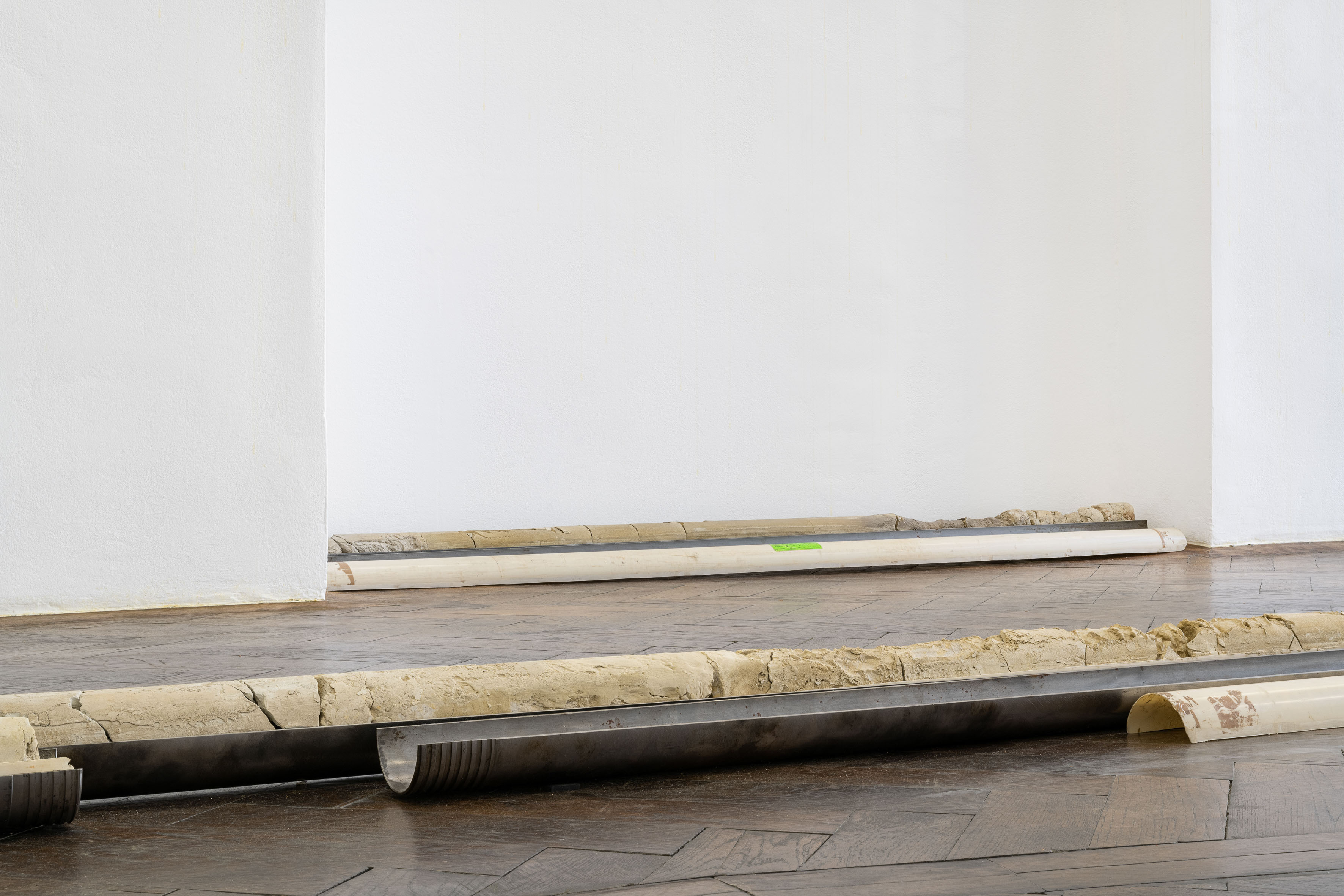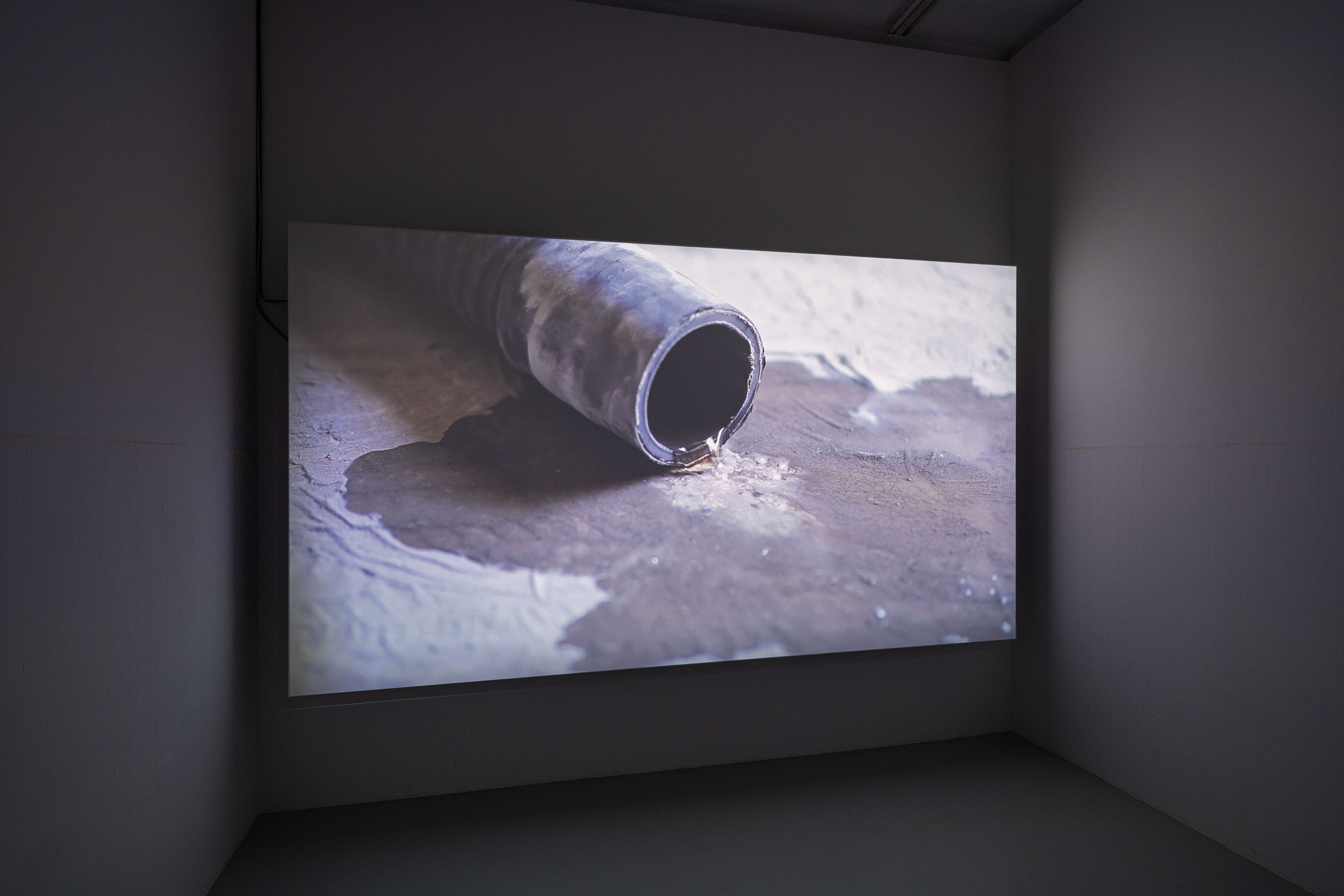YYYYMMDD >>> BACK HOME <<< >>> SELECTED FEATURES <<< >>> HIDDEN ARCHIVE <<<
[20220920]
WATER BEING WASHED AWAY with works by GIORGIO ANDREOTTA CALÒ, LATIFA ECHAKHCH, PHILLIP LAI, BASIR MAHMOOD and CLAUDIA PAGÈS RABAL at GALERIE HUBERT WINTER curated by ALESSANDRO RABOTTINI [from 20220909 to 20221022]
[Photos: Simon Veres]













The group exhibition Water Being Washed Away brings together works that use dynamics or images of liquid infiltration as political and existential metaphors. Through different forms of erosion that are material and symbolic, the exhibition establishes a dialogue between artists who look at how physical, cultural, and biographical positions of distance can question and nuance the idea that aesthetic and political lineages are stable notions, fixed in time and in behaviour.
Following the different ways in which fluids are referred to in the works by Giorgio Andreotta Calò, Latifa Echakhch, Phillip Lai, Basir Mahmood, and Claudia Pagès Rabal, the show metaphorically infiltrates the cultural and economic structures of everyday objects together with our psychological understanding of them. By bringing the works into close proximity with each other, the exhibition layout aims at taking the viewer across a landscape of associative leakages between permanence and deterioration, belonging and estrangement, often collapsing the distinction between the authentic and the fabricated.
The artists operate within a porous circulation and distribution of materials and meanings, relaying them according to a personal methodology that consumes and transforms moments and fragments of reciprocal interpretation between the East and the West, the South and the North.
French-Moroccan artist Latifa Echakhch (1974, lives between Vevey and Martigny) imbues a personal dimension into her spatial and architectural interventions, often questioning ideas of identity and nationality within a globalized context. For this exhibition, the artist recreated Gaya (E102) Horizon, a site-specific installation originally conceived in 2010 that subtly infiltrates the architecture beyond its almost imperceptible visual presence. The work consists of a horizontal yellow line that stretches on all the gallery walls. It is made of a cheap, flavourless food colouring commonly used in North Africa to visually simulate the more expensive saffron and here diluted with water to create a minimalistic dripping, the residual horizon of the artist’s cultural context of origin. In its hieratic simplicity, Gaya (E102) Horizon deploys a synthetic material whose function is to visually dignify food and, in so doing, suggests a multitude of meanings: it interrogates concepts of authenticity and belonging while asserting the scale with which the unseen and the unheard innervates societies. By running throughout the entire exhibition space, the work also functions as the eroded foundations for the narrative of the show: if saffron, in fact, is a cultural signifier that has permeated many cultures through time, the work itself permeates the skin of the architecture, for when the show will be over and the walls will be painted again, it will be kept there as a secret.
Interested in processes of material and formal abstraction, the sculptures by Kuala Lumpur-born, London-based artist Phillip Lai (1969) bear a resemblance to ubiquitous, industrial objects that the artist may have found or purchased but that, instead, he has often recreated. Prosaic objects like receptacles and vessels are analytically dissected throughout a sculptural process that finally restores them in their complex, silent self-evidence. Lai works by partial fictionalisations of the chosen objects, and that operation becomes most visible in their often enigmatic assemblage or morphological distortion. Expulsions (2019) is a series of steel pipework joined together which bears an accretion of red, white, and bright orange bottles hanging from its top. The latter are meticulously and manually cast in a translucent, fragile polyurethane resin and ambiguously resemble pressurized containers, like diving oxygen tanks or fire extinguishers. In their essence and position, these flasks suggest differing narratives of loss and retention: a sense of latent alarm, a collective collection of provisions, and the vigilant waiting of a multitude.
Through her multi-media practice, Spanish artist Claudia Pagès Rabal (1990) often fuses personal memories with a wider concern for environmental and socio-political issues. Ventiladors, petxines (sur)(2022) is a spatial and sculptural intervention that, in its discreet minimalism, borders with an apparent functionality. A series of fans are distributed in the gallery space: they were customized by the artist who welded the lids with spiral shapes and then encrusted them with shells collected over the years on the beaches of Tarragona. Each fan is equipped with a system that distributes different essences: bougainvillea, oleander, cement, and wet sand. Together, they evoke the Mediterranean coasts and the diverse implications that travel trajectories and maritime landing may have: the sea as a space of leisure, as a network of exchanges of goods, as a horizon of conflicts, hopes, and migrations. Using shells that are disappearing from the progressively eroded Spanish coasts, Pagès Rabal composes an olfactory and acoustic landscape that is as dematerialised as the maritime routes, and as pervasive as the immaterial forces that shape memories and existences.
In a poetic parallel, Italian artist Giorgio Andreotta Calò (1979, lives in Italy and the Netherlands) composes conceptual landscapes from the relics of natural elements, architectures, and cities, revealing their dormant or imaginary aspects. His Carotaggio (Venezia) (2014) consists of a series of vertical borings from the Venetian lagoon, where the artist was born. The core drilling that he requested to perform reached the layer called “Caranto”, located at a depth of nine meters and which marks the passage between Pleistocene and Holocene within the Venetian stratigraphic sequence. This layer separates the lagoon water from the freshwater subsoil and it functions as the backbone of the floating city, whose monumentality rests on a daily dynamic of infiltration. With its horizontal arrangement of solid and yet precarious stilts, the installation forms a dry island that in its shape and materials stands for the abraded foundations upon which Venice is built: an eroded horizon of accumulated matters and dislocated fragments of time that manifest thousands of years of geological and urban transformations.
The exhibition culminates in the work that actually originated the curatorial concept, meaning Ahmedpur East (2022) by Pakistani artist Basir Mahmood (1985), who uses video and photography to explore the aesthetic and political aspects of everyday life. The almost forensic yet melancholy quality of his video works is enhanced by the process of their making, with the artist often sending instructions to film crews in Lahore from his current home in Amsterdam where he then edits the filmed material. In Ahmedpur East, a brown liquid is seen either vigorously coming out from a hose, or delicately being poured from a vase into a tray. Contemplative and menacing at the same time, the work attempts to create a memorial for the 219 people that died engulfed in a fireball while trying to collect the fuel that spilled out from a crashed oil tank in Ahmedpur East. Mahmood asked a group of gas station workers to fill a series of household containers (like those used by the victims) and had them filmed within a construction site, composing a wordless elegy of solemn gestures and flowing sounds. Here the dynamics of the liquids and the alternating orchestration of dispersion and pouring sublimate the violence of the event while building the tension of a sober remembrance.
[Text: Alessandro Rabottini in collaboration with Bianca Stoppani]
©YYYYMMDD All content and design by Daniela Grabosch + Ricardo Almeida Roque unless otherwise stated. Images, Videos and Texts can only be used under permission of the author(s).